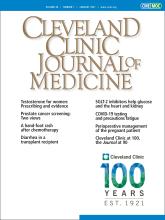ABSTRACT
Sodium-glucose cotransporter-2 (SGLT-2) inhibitors are an exceptionally versatile class of medication, and their glycemic and nonglycemic benefits could help millions of patients with type 2 diabetes. Of note, they have been shown to improve cardiac and renal outcomes, much-needed benefits in patients with type 2 diabetes, who are at a higher risk for developing cardiac and renal dysfunction than those who do not have diabetes. The indications for SGLT-2 inhibitors may continue to expand as ongoing clinical trials provide more insight into these drugs.
- Copyright © 2021 The Cleveland Clinic Foundation. All Rights Reserved.
- M. Cecilia Lansang, MD, MPH
- Vinni Makin, MBBS, MD, FACE⇑
- Director, East Region, Department of Endocrinology Diabetes, and Metabolism, Cleveland Clinic; Assistant Professor of Medicine, Cleveland Clinic Lerner College of Medicine of Case Western Reserve University, Cleveland, OH
- Address:
Vinni Makin, MBBS, MD, FACE, Department of Endocrinology Diabetes, and Metabolism, F20, Cleveland Clinic, 9500 Euclid Avenue, Cleveland, OH 44195; makinv{at}ccf.org
ABSTRACT
Sodium-glucose cotransporter-2 (SGLT-2) inhibitors are an exceptionally versatile class of medication, and their glycemic and nonglycemic benefits could help millions of patients with type 2 diabetes. Of note, they have been shown to improve cardiac and renal outcomes, much-needed benefits in patients with type 2 diabetes, who are at a higher risk for developing cardiac and renal dysfunction than those who do not have diabetes. The indications for SGLT-2 inhibitors may continue to expand as ongoing clinical trials provide more insight into these drugs.
- Copyright © 2021 The Cleveland Clinic Foundation. All Rights Reserved.









